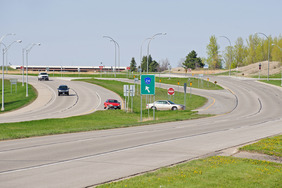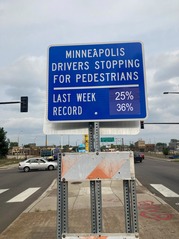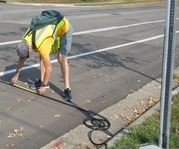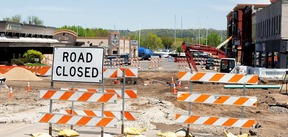|
Transportation Research Update
 Increasing Support for Innovative Traffic Solutions

TRAFFIC & SAFETY — Always on the lookout for ways to increase safety for all road users, Minnesota’s city and county engineers are keen to implement strategies that can reduce the severity of crashes. But often these lesser-known innovations are met with resistance from a skeptical public, resulting in project delays, additional costs and lost lives.
Across the country, the Restricted Crossing U-turn, commonly called the JCUT, has demonstrated overwhelming success as a safer alternative to traditional intersections on four-lane divided highways. More than a dozen of these nontraditional intersections are already installed in Minnesota. Data show they decrease severe crashes and fatalities by as much as 70%. Despite this finding, the JCUT can be a hard sell for local public transportation agencies. This research gives agencies the tools and guidance needed to broaden stakeholder support of JCUTs and increase implementation across the state.
|
Improving Driver Yielding to Pedestrians at Intersections

TRAFFIC & SAFETY — With pedestrian deaths at a 30-year high, MnDOT and local transportation agencies strive to find methods to increase pedestrian safety. Previous research began to identify multifaceted strategies to increase driver yielding at crosswalks without traffic signals, including police enforcement, signs and other methods. A more recent study provides agencies with a deeper understanding of which strategies work at both unsignalized and signalized intersections.
Researchers installed a variety of signs and other safety measures at several crosswalks and intersections in Saint Paul and Minneapolis, collecting data on driver yielding before installation and for four months afterward. A comparison of these results to data collected at nearby intersections without additional safety measures showed modest improvements in driver yielding in some intersection types. Investigators provided recommendations and considerations, including how to plan and implement police enforcement of yielding laws, which was not explored in this study.
|
Impact of Speed Limit Changes on Driving Speeds

TRAFFIC & SAFETY — Speeding is a leading contributing factor in crashes with serious injuries. MnDOT and local transportation agencies continually seek to make roads safer for all users, and lowering speed limits may be one solution. It is not clear, however, if simply posting a new speed limit actually causes drivers to slow down. A new state law allowing cities to change speed limits in urban areas more easily presented an opportunity to explore driver behavior.
St. Louis Park had planned a citywide speed limit change and agreed to partner with researchers to analyze driving speeds before and after the posted speed limit changes. Data from traffic counters allowed speed calculations on 24 streets, some with speed limit changes and others used for comparison purposes. On average, speeds decreased 1 mph to 2 mph—considerably less than the speed limit changes—on streets where the speed limit changed and on those where the speed limit remained the same. Researchers noted that driving is a habitual behavior and suggested that it may take longer for a driver to adapt to a lower speed limit. The transportation agencies may consider evaluating the same sites in several years.
|
Impacts of Highway Improvements on Adjacent Businesses

POLICY & PLANNING — Highway projects can improve the driving experience and increase access to businesses. Some smaller establishments, however, may suffer negative impacts both during and after construction. During construction, access may be temporarily more difficult or undesirable for patrons. After construction, improvements and increased traffic may entice larger chain stores to move in, which often displaces smaller enterprises. MnDOT has new evidence to help target assistance to vulnerable businesses before and during road construction projects.
Using multiple data sets, researchers looked back nearly two decades at business sales, employment and closures in areas that experienced significant highway projects. Analyses of retail stores, restaurants and personal services establishments showed that larger chain businesses saw some benefits when highway projects improved traffic flow. Smaller, single-location establishments in urban areas were the most vulnerable to some aspects of the construction process. Comparing these results to previous research on transit projects, researchers found that transit infrastructure construction tended to have greater impacts to nearby businesses than did highway projects.
|
Upcoming Research Events
-
CTS Webinar: Mobility, Access, and Transportation Insecurity Program Introduction and Listening Session
November 13, 2023, 11 AM - 12 p.m. CST
-
2023 Minnesota Toward Zero Deaths (TZD) Conference
November 14 - 15, 2023 | Rochester, MN
-
CTS Webinar: Max-Pressure Signal Timing on Minnesota Roads
November 20, 2023, 3:00–4:30 p.m. CST
-
TRB Annual Meeting
January 7-11, Washington DC
Conference Registration
-
Minnesota Night at TRB
January 8, 2024, 6:00–8:00 p.m. EST
RSVP required
-
Minnesota Transportation Conference and Expo
May 29-31, 2024 | St. Paul, MN

|
|
Tell us what you think!
We are looking for feedback for our Gov Delivery services and would like to hear from you. Your comments are valuable to us. Tap the button below to participate.
|
|
|
MnDOT invites and encourages participation by all people in their programs, services and activities.
If you need an ASL, a foreign language interpreter, or documents in an alternative format (such as braille, large print or in a different language) at no cost, please email your request to Janet Miller at ADArequest.dot@state.mn.us or call 651-366-4720. Relay service: 711.
If you need any other reasonable accommodation to participate (such as seating modification or auxiliary aids), please email your request to Accessibility.DOT@state.mn.us or call 1-833-400-8432. Relay service: 711.
|
|
|
|
|